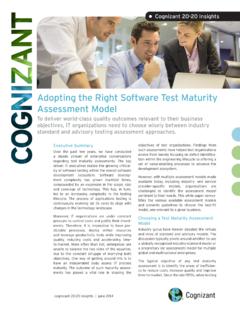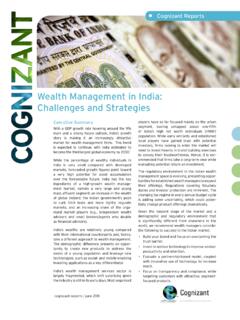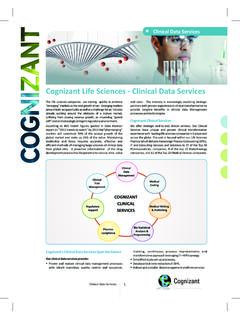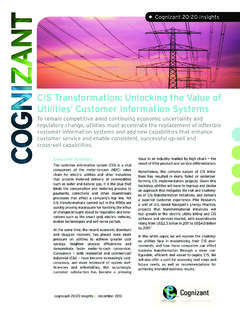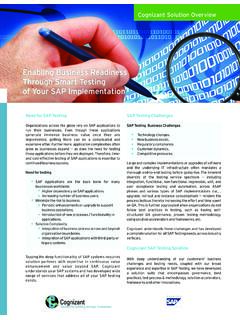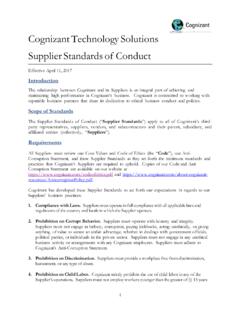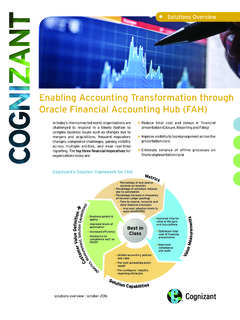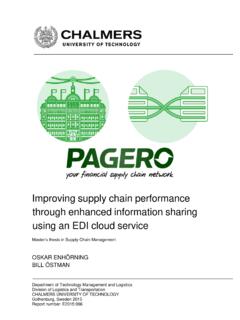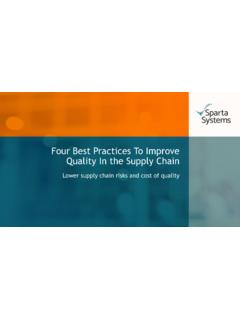Transcription of Performance Management in the Transportation and Logistics ...
1 White paperMaximizing supply chain Performance in the Transportation and Logistics IndustryCognizant White PaperExecutive SummaryManaging Transportation and Logistics has been acritical focus area for manufacturers, distributorsand third-party Logistics players in their pursuit ofdeveloping a lean, agile and efficient customer-oriented supply chain . Among the biggestchallenges these players face today ismaintaining the delicate balance of increasedmaterial and Transportation costs against theexpectations of improved service levelsmandated by customers.
2 To achieve this end,many industry players are collaborating withtheir key customers and vendors to improve theirprocesses and systems and provide better servicequality, reduce costs and improve visibility. Togain full advantage of such collaborativeinitiatives, building an efficient and effectivesupply chain intelligence infrastructure is a must. To achieve better customer service at reducedcosts, organizations are increasingly adoptingthe two levers of process improvement and tech-nological breakthroughs in track-and-trace,improved control systems and IT innovationssuch as cloud platforms.
3 To fully realize the ben-efits from these initiatives and move toward anera of continuous improvement in their opera-tions, organizations will also need to realign theirlogistics Performance measurement strategies. Performance Management is a methodology tooptimize the execution of business strategy. Itconsists of a set of integrated, closed-loop,analytic processes, supported by technology,addressing financial as well as operational enables a business to define, measure andmanage its Performance against strategic Management has a few aliases,such as corporate Performance Management (CPM), business Performance Management (BPM), enterprise Performance Management (EPM), etc.
4 But simply put, it is a strategicapproach to improving business 1 Performance vs. Complexity on EfficiencyEfficiencySupply chain ComplexityPerformanceComplexity=f(Custom ers, Geography, Suppliers, Carriers, ) Performance =f(Productivity, Accuracy, Response Time) white paper2 Need for Performance Management ofLogistics OperationsYou Can t Manage What You Can t Measure In spite of the increased focus on Logistics bymost companies, the gap is widening betweenlogistics cost leaders and laggards. Logisticsleaders are unlocking the value of the enterpriseacross the value chain .
5 Some of the key trendsinfluencing Logistics decisions are as follows:nOrganizational focus on managing logisticscostsThe total cost of Logistics for a typical compa-ny is 7% to 12% of sales1and is growing due toincreasing supply chain complexities. Thus,there is an increased focus from corporatemanagement on controlling and managingthis cost. Logistics costs typically follow eco-nomic cycles. During times of growth, theavailable capacity becomes constrained, andrates rise. When recession hits, rates fall dueto competition among service providers to uti-lize the surplus capacity.
6 Managing capacityand utilization is often a tightrope walk formost service providers and proves to be a dif-ferentiating factor for most companies. While most organizations have cost data at asummary level, access to details are oftenfound lacking. Drill-down data at lower levels isrequired for identifying issues and for conduct-ing analysis on high-cost line items. Consistentand credible data is required for organizationsto be able to make informed emphasis on execution excellencein the supply chainSpeed is of the essence in the new order ofsupply chain Management .
7 Real-time flow ofinformation aids in shrinkingcycle times and improvingthe response to changes andexceptions. Service providershave to be quick to spot theshift in market demands andchange their focus to rapidlygrowing regions. At the sametime, identifying issues instable markets and resolvingthem before competitorstake away share is of paramount market share and revenue could bedue to multiple factors, the identification ofwhich can turn out to be nightmare withouthaving the mechanisms in place to capture andanalyze the data. Logistics as DifferentiatorCompanies are increasingly looking at logisticsfor improving customer experience and fordifferentiation.
8 Meeting service levelagreements is a basic requirement for movingfrom customer satisfaction to customer s demanding customers require not justfulfillment of requirements, but also cooperationand alignment with their service partners formutual benefit and revenue growth. Sharing data with upstream and downstreampartners and aligning the key metrics across thevalue chain are among the steps companieshave taken in this direction. industry leadersprefer to partner with Logistics service providersthat are adept at moving in step with Performance has gradually movedfrom an internal focus on strategic objectives, tomeasuring Performance across the value chainto include the upstream and downstreampartners.
9 In addition, the need to benchmarkagainst industry leaders is forcing companies tolook beyond home-grown s demanding customers require not justfulfilment of requirements,but also cooperation andalignment with their servicepartners for mutual benefitand revenue Size Doesn t Fit AllThe measurement of Logistics operationalmetrics varies widely from one companyto another. For example, in a survey of 247respondents conducted by supply ChainDigest, only 40% said their primarymeasure of Logistics costs is percent ofsales. The other responses were splitamong measuring Logistics costs asabsolute costs, as a cost per unit of weight(hundred weights, kilograms, etc.)
10 , costper unit measure (case, unit) and activity-based costing as the primary such wide variation in measurementof the basic metrics, it is no wonder thatthe Logistics measurement used by oneorganization may not be suitable foranother. Even within the same industry ,where processes might be similar,markedly different methods of measuringmetrics exist. white paper3 Limitations of Current PerformanceManagement SystemIs This You?In a survey conducted by InformationWeekin2008, 91% of Transportation and logisticscompanies deployed BI tools , only 46% of them expected to deliverbetter business intelligence to more employees,more quickly, in that year.

